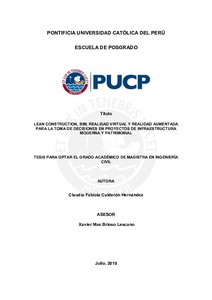| dc.contributor.advisor | Brioso Lescano, Xavier Max | |
| dc.contributor.author | Calderón Hernández, Claudia Fabiola | es_ES |
| dc.date.accessioned | 2019-09-09T19:57:20Z | es_ES |
| dc.date.available | 2019-09-09T19:57:20Z | es_ES |
| dc.date.created | 2019 | es_ES |
| dc.date.issued | 2019-09-09 | es_ES |
| dc.identifier.uri | http://hdl.handle.net/20.500.12404/14941 | |
| dc.description.abstract | Las tecnologías que se han desarrollado en los últimos años benefician a las diversas industrias, mejorando los márgenes e indicadores. Es así el caso de la herramienta Building Information Modeling (BIM), la realidad virtual (RV) y la realidad aumentada (RA). En el sector de la construcción, los ejecutores son reacios a utilizar nuevas tecnologías, desperdiciando las oportunidades de mejora que estas brindan. El uso del BIM en proyectos de construcción se ha venido impulsando en los últimos años, obteniendo muy buenos resultados al integrarse con la filosofía Lean Construction. Sin embargo, la implementación de las tecnologías de visualización RA y RV está en su primera fase de investigación. En esta tesis se revisa y determina el estado del arte de la realidad virtual, la realidad aumentada y sus aplicaciones en la industria de la construcción. A partir de ello, se proponen metodologías de aplicación en las fases de diseño, planificación y ejecución de un proyecto de edificación. Luego se procede a realizar un estudio de caso en las fases de diseño y planificación de un proyecto de infraestructura patrimonial, evaluando el impacto de su uso y aplicabilidad. De igual manera se aplica los protocolos generados en un estudio de caso de edificación durante la fase de construcción. Finalmente, se miden y analizan los resultados obtenidos, y se realizan encuestas al equipo de trabajo del proyecto. Los resultados indican que a pesar de no contar aún con un proceso automatizado para el modelamiento en BIM de la infraestructura patrimonial, su uso en este tipo de estructuras tiene un gran potencial para mejorar sus estrategias de conservación. De igual modo, existe una gran compatibilidad entre el sistema de gestión de estructuras patrimoniales y las herramientas de la filosofía Lean Construction, así como de la tecnología de RV, logrando una mejora en la fase de diseño, permitiendo que el proceso de toma de decisión sea más transparente y eficaz. En cuanto a la edificación moderna, los resultados validan la metodología de implementación del uso de RV/RA en un proyecto de construcción. El uso de la RV/RA potencia la comunicación dentro del equipo del proyecto y disminuye el tiempo de comprensión de la información, así como de la toma de decisiones. | es_ES |
| dc.description.abstract | The technology developed in the last years benefits several industries while improving margins and indicators. This is the case of the BIM tool, virtual reality (VR) and augmented reality (AR). In the construction industry, project managers are more reluctant to using these new technologies, wasting the opportunities of improvement they give. The use of BIM in construction projects has been boosted in the last years, obtaining very good results by integrating it to the Lean Construction philosophy. However, the implementation of visualization tools like VR and AR it’s still on the first phase of research. On this thesis, the state of the art of virtual reality, augmented reality and its application on the construction industry is reviewed and determined. From there, a case study on the design phase of a heritage structure project is done, to evaluate and validate its use during the design phase. In a similar way, it is applied to a concrete building project during the construction phase. Finally, the results obtained are measured comparing them through surveys performed on the project team. The results indicate that even though there is not an automated process to model a heritage infrastructure on BIM, its use on these types of structures has great potential to improve the conservation strategies. Likewise, there is a great compatibility between the management of heritage structures and the Lean Construction philosophy, and the use of its tools, as well as the VR technology promotes an improvement during the design phase, allowing the decision-making process to be more transparent and efficient. As for the building projects, the results validate the methodology of VR/AR implementation in a construction project. The use of VR/AR improves communication within the project team and reduces the time needed for the comprehension of the project documentation and the decision-making process. | es_ES |
| dc.description.uri | Tesis | es_ES |
| dc.language.iso | spa | es_ES |
| dc.publisher | Pontificia Universidad Católica del Perú | es_ES |
| dc.rights | info:eu-repo/semantics/closedAccess | es_ES |
| dc.subject | Construcción--Planificación | es_ES |
| dc.subject | Industria de la construcción | es_ES |
| dc.subject | Realidad aumentada | es_ES |
| dc.subject | Toma de decisiones | es_ES |
| dc.title | Lean construction, BIM, realidad virtual y realidad aumentada para la toma de decisiones en proyectos de infraestructura moderna y patrimonial | es_ES |
| dc.type | info:eu-repo/semantics/masterThesis | es_ES |
| thesis.degree.name | Magistra en Ingeniería Civil | es_ES |
| thesis.degree.level | Maestría | es_ES |
| thesis.degree.grantor | Pontificia Universidad Católica del Perú. Escuela de Posgrado | es_ES |
| thesis.degree.discipline | Ingeniería Civil | es_ES |
| renati.advisor.dni | 09856898 | |
| renati.discipline | 732267 | es_ES |
| renati.level | https://purl.org/pe-repo/renati/level#maestro | es_ES |
| renati.type | http://purl.org/pe-repo/renati/type#tesis | es_ES |
| dc.publisher.country | PE | es_ES |
| dc.subject.ocde | https://purl.org/pe-repo/ocde/ford#2.01.01 | es_ES |





